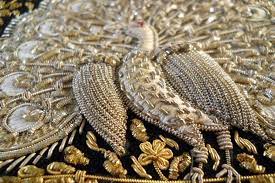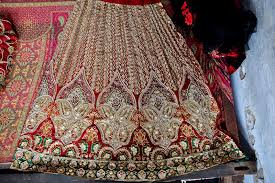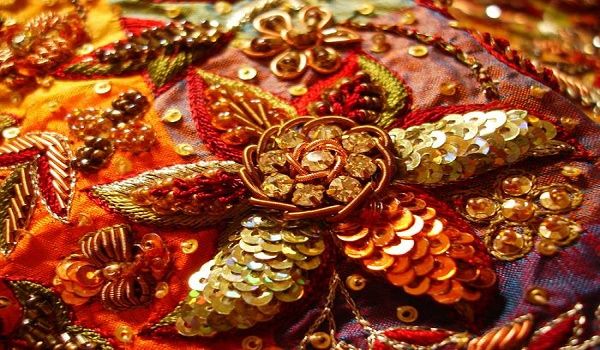

Another royal type of Indian surface craft – Zardozi, where “zar” means gold and “dozi” means embroidery. Made from gold and silver threads (zari), they are sometimes decorated with studs of pearls and precious stones, giving them a royal look. According to Strands of Silk, it originated in Persia and came to the Indian city of Lucknow via the Mughal Emperor Akbar, who used it for clothing and interior decoration. Ancient Indian texts such as the Ramayana and Mahabharata also mention zardozi craftsmanship used in the king’s garments of pure gold.

Many creators like Manish Malhotra, Sabyasachi, Suneet Varma, Tarun Tahiliani, Shyamal and Bhumika etc.
These types of Indian surface works are often used in their collections. Patterns include peacocks, flowers, leaves and more. Today, it is mainly used in wedding dresses, fashion collections, dresses, clutches, mojris, etc. Heavy, beautiful and durable!
9.
Kundan Work

Kundan is a rich and intricate Indian surface work where sequins of drops or leaves are glued onto the fabric surrounded by gold and silver (zari) threads. It was introduced during the Mughal era around the 19th century in the regions of Rajasthan and Gujarat and was mainly used in heavy bridal sarees, sheaths and accessories.
There is a huge market not only for fabrics bu

t also for kundan decorative accessories mainly using gold and meenakari artwork for special occasions. The pattern is similar to zardozi, which gives the fabric a 3D look. It is also seen in bridal attire in South Indian weddings.
Personally, I love this look, mainly this Indian blouse paired with a Kanjeevaram silk saree. Due to the weight of all the sequins, kundan made sarees and lehengas tend to be heavy and lined with another fabric such as satin to support it.
10. Kasuti handicraft In
Kasuti, “kai” means hand, and “suti” means cotton, which means handicraft made of cotton woven on cloth. According to Direct Create, the traditional folk embroidery of the Dharwad region in western Karnataka originated during the Chalukya period in the 15th century.
Ilkal sarees, Dharwad sarees, Chandrakali black silk sarees, Ravike or blouses, Angi or kurtas are famous products of this embroidery.
From the smallest to the most intricate pattern, masterfully finished in 64 art forms in vibrant colors and contrasting cotton yarns. It is a combination of four embroidery stitches – Negi, Gavanthi, Murgi and Menthi which can be done individually or in combination. Designs based on rangoli designs are common, such as sunflowers, chariots, conchs, shivlinga, doves, swastikas, and elephants. I would love to wear these very light sarees while giving an elegant look!
11. Phulkari
Next is Phulkari, where ‘Phul’ means flower and ‘Kari’ means work of art. It is traditionally practiced by women in the Punjab region. We hear of the famous Punjabi love story of Heer-Ranjha, which mentions the first record of this craft in the 18th century. Phulkari is used for daily and occasional use in the form of dupattas, handbags, patiala suits, etc.
Designers such as Manish Malhotra and Kanika Goyal have used this artwork in their special fashion week collections.
Hand-spun embroidery comes in many colorful forms such as multicolored phulkari such as Satranga (seven colors) and Panchranga (five colors); Leheria (sea waves); Dhoop Chawn which literally means sun and shade (a combination of white and golden yellow); and a lot of. The embroidery gives it a rich mosaic effect, with unique untwisted silk threads in bright colors, geometric or floral patterns.


12. Kashida embroidery
Kashida embroidery is made with thick threads and colored beads to create different natural patterns, usually paisley patterns.
Designed for men, it originated in Kashmir and was traditionally worn by Mughal emperors. Mainly used for dau shalos, pashmina shawls, jackets, saris, upholstery etc.
According to an article published by Vogue magazine, Tarun Tahiliani talks about her new wedding dress collection, which includes Kashida embroideries. He mentions: “Kashida has been a big part of my growing up story and constantly surprises me, but he has all the qualities I love to talk about. He’s malleable, he’s got color, he’s lightweight, he’s versatile.

Kashida or Kashidakari sews the beautiful essence of Kashmir with bright colors. There are other types of Indian surface craftsmanship in Kashmir, such as Sozni craftsmanship, a very fine and intricate needlework; Aari or Crewel embroidery, which is done using flower-inspired crochet hooks. patterns and built around the fabric with chain stitches. The patterns used are mainly natural elements such as cypress leaves, vines, animals, flowers, vines, lotuses, mangoes, almonds, etc.
13. Chamba Rumal


Rumal in Literally means handkerchief in Hindi.
Chamba rumal is an embroidered handkerchief craft originating from Chamba in Himachal Pradesh. According to The Better India, the rulers of the Chamba kingdom kept embroidery in the 18th and 19th centuries. Embroidered dresses are often given to girls at their weddings and are common in the hills and valleys of Himachal Pradesh.

This beautiful embroidery uses simple natural designs such as trees, flowers, fruits and more. In bright colors.
It also contains intricate designs such as mythological, Raas-Leela scenes such as hunting and wedding scenes. Both men and women use these rumals and shawls. Can you imagine their embroidery so perfectly done that the fabric is the same on both sides? For example, they kept embroidered Rumals as heirlooms for future generations and used them in ceremonies.
Indian Culture Preserved Through Handicrafts
Various Indian surface works are popular not only in Indian market but also in international market.
Craftsmanship has gained interest over time. Embroidery is also back in fashion, with contemporary styles ranging from bridal to casual, party to formal. Top designers like Anita Dongre, Tarun Tahiliani, Sabyasachi and many more. Also brings an Indian essence to a modern silhouette.
This type of Indian surface work is one of the beautiful gifts that the rich Indian culture has to offer. However, these traditional handicrafts also tell the story of India, from the picturesque valleys of Kashmir to the opulent royal attire of the Mughals in Delhi and the nawabs of Lucknow.
